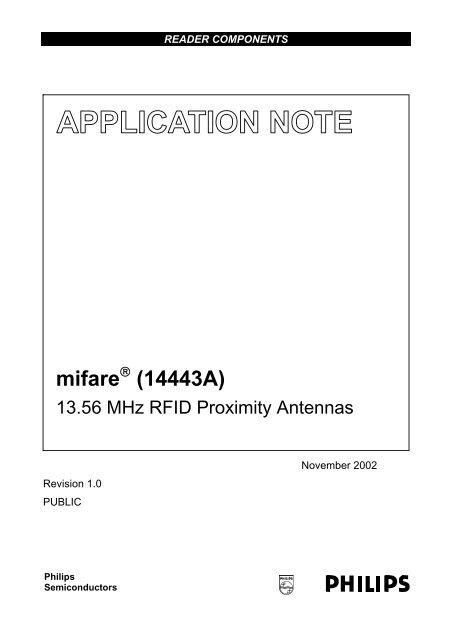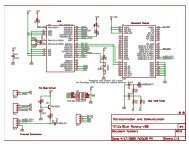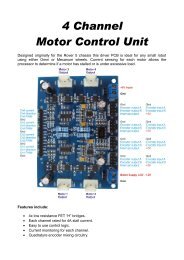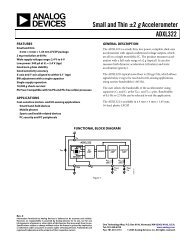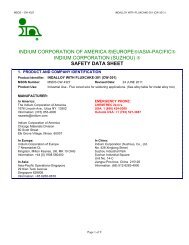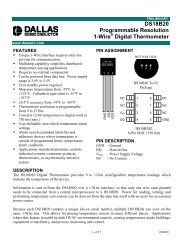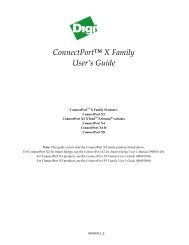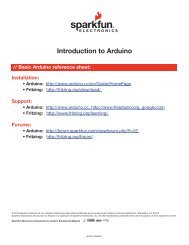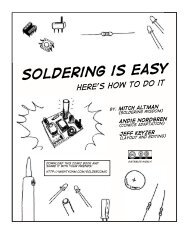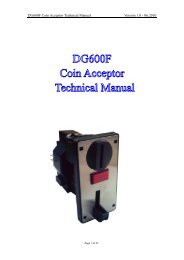AN78010 - NXP.com
AN78010 - NXP.com
AN78010 - NXP.com
Create successful ePaper yourself
Turn your PDF publications into a flip-book with our unique Google optimized e-Paper software.
3Il s’engage à ouvrir toutes ses actions à l’ensemble de la population sansdistinction de quelque sorte que ce soit.FINANCEMENT DES ACTIVITES DE JUMELAGEArticle 6Les frais de fonctionnement courants de l’association doivent être couverts parses propres ressources.La <strong>com</strong>mune met à disposition du <strong>com</strong>ité des locaux à titre gratuit. qui serontutilisés conformément à l’objet du <strong>com</strong>ité. La réservation de ces locaux par le<strong>com</strong>ité fera l’objet d’une demande auprès de la <strong>com</strong>mune.La <strong>com</strong>mune assurera les responsabilités civiles et multirisques de ces locaux etrenonce à un recours contre l’association, en sa qualité d’occupante. L’associations’engage à contracter toutes les assurances pour garantir sa responsabilitécivile.Article 7Dans le but de donner au <strong>com</strong>ité les moyens nécessaires pour exercer lesfonctions qui lui sont déléguées, la <strong>com</strong>mune versera chaque année au <strong>com</strong>ité unesubvention.Cette dernière sera votée par le conseil municipal <strong>com</strong>pte tenu des possibilitésde la <strong>com</strong>mune et des <strong>com</strong>ptes et des projets présentés par le <strong>com</strong>ité.Article 8La subvention est destinée notamment à couvrir :- - les frais d’organisation matérielle des actions et manifestations dontl’organisation in<strong>com</strong>be au <strong>com</strong>ité.- - l’aide aux jeunes et aux associations locales à l’occasion de leursdéplacements dans le cadre des échanges et activités du jumelage- - les frais de promotion des jumelages.- - les frais de déplacements de personnes pour un voyage d’études ou serendant dans l’une des villes jumelles pour participer à une réunion de travail.Article 9Cette subvention ne peut en aucun cas servir à aider même partiellement- - les voyages de détente, de loisirs ou touristiques des habitants sedéplaçant à titre individuel ou en groupes, dans le cadre des visiteshabituelles entre villes jumelles.- - le déplacement, l’hébergement, le repas ou autre frais de même nature desadministrateurs de l’association, y <strong>com</strong>pris les membres de droit, à l’exceptionde ceux prévus à l’article 8.- - les frais d’organisation des réceptions officielles dont le <strong>com</strong>ité aurait étéchargé par la <strong>com</strong>mune Ces frais seront pris en charge par le budget<strong>com</strong>munal dès lors qu’ils auront été autorisés par le Maire sur présentationd’un devis établi par le <strong>com</strong>ité.
Philips Semiconductors Rev. 1.0 November 200213.56 MHz RFID Proximity Antennas mifare ® (14443A)2 HOW TO USE THIS DOCUMENTThe chapter 3 of this document shows the basic principles of the RF interface as it used with MIFARE ® . Thegeneral understanding of this principle helps to do a fast and reliable antenna design based on Micorereader ICs, but none of the given formulas (especially those in the annex) are necessary to design such anantenna.The chapter 4 describes some basic facts about the PCD antenna, its optimum size, and how to minimizeenvironmental influences. The given rules and design re<strong>com</strong>mendations should generally be considered fora PCD antenna design. This is true for a Micore based antenna design, too.The chapter 5 gives an overview and <strong>com</strong>parison of the two antenna design principles for Micore antennas.A help is given to find the best solution based on certain application requirements.This application note cannot and does not replace any of the relevant datasheets.“Card” in this document means a contactless smart card according to the ISO14443A (or MIFARE®) or acontactless tag / label according to the ISO15693 (or I-Code ® ).“Micore” includes all contactless reader ICs as the MF RC500, MF RC530, MF RC531, SL RC400 and theCL RC632. For all of these ICs the antenna matching is the same.Remarks and Comments are given in italic letters (blue marked).4 PUBLIC
Philips Semiconductors Rev. 1.0 November 200213.56 MHz RFID Proximity Antennas mifare ® (14443A)3 THE MIFARE ® RF INTERFACEThe MIFARE ® technology describes an ISO 14443-Type A <strong>com</strong>pliant RF interface for a <strong>com</strong>municationbetween a PCD and a PICC.Table 1 gives a short overview on the MIFARE ® RF interface. Essentially the MIFARE ® RF interface followsthe transformer principle, although both the PCD and PICC antenna of course are resonance circuitries asantennas usually are. The PICC is passive with no onboard battery. Thus, an energy transmission from thePCD to the PICC is required in addition to the <strong>com</strong>munication (data transmission) in both directions betweenthe PCD and the PICC (see Figure 1).Table 1: Overview MIFARE ® RF interfaceEnergy transmissionOperating frequencyCommunication structureData rateData transmissionRWD CardCard RWDTransformer principle; MIFARE ® card is passive13.56 MHzHalf duplex, reader talks first105.9 kHz100 % ASK, Modified Miller CodeLoad Modulation, Subcarrier 847.5 kHz,OOK, Manchester CodeIn the following the fundamentals of the MIFARE ® RF interface are described starting with the basic energytransmission. Finally, the data transmission and the used data coding in both directions will be shown.Figure 1: Mifare Interface Principle5 PUBLIC
Philips Semiconductors Rev. 1.0 November 200213.56 MHz RFID Proximity Antennas mifare ® (14443A)3.2 Data Transmission PCD PICCTo transfer data between the PCD and the PICC a half-duplex <strong>com</strong>munication structure is used. The PCDalways starts the <strong>com</strong>munication (“reader talks first”). The data transmission from the PCD to the PICC usesa 100% ASK modulation according to the ISO14443 Type A. Figure 3 shows a typical signal shape.Figure 3: Data Transmission PCD PICC, typical signal shapeDue to the quality factor Q of the antenna the transmitted signal is deformed to the shape shown in Figure 3.This shape can be used to measure the tuning of the antenna. For details refer to the “MIFARE ® and I Code,Micore Directly Matched Antenna Design”.As the PICC is passive, the energy for the PICC has to be provided during the <strong>com</strong>munication between PCDand PICC. Therefore, MIFARE ® (ISO14443A) uses an optimised coding to provide a constant level of energyindependently from the data transmitted to the PICC. This is the modified Miller code, which is shown isshown in Figure 4 in detail.7 PUBLIC
Philips Semiconductors Rev. 1.0 November 200213.56 MHz RFID Proximity Antennas mifare ® (14443A)modulated carrierdata bit "1":9.44 µs3µsdata bit "0":9.44 µsprevious bit "0"3µs9.44 µsprevious bit "1"Figure 4: Data Transmission PCD PICC, Miller CodingThe data rate of MIFARE ® is 105.9KHz, so the length of a bit frame is 9.44µs. A pulse in the Miller codinghas a length of 3µs.A logical ‘1’ is expressed with a pulse in the centre of the bit frame.Two possibilities are given to code a logical ‘0’. This coding depends on the previous bit:If the previous bit was a ‘0’, the following ‘0’ is expressed with a pulse of 3µs at in the first half of the next bitframe.If the previous bit was a ‘1’, the following ‘0’ is expressed without a pulse in the next bit frame.8 PUBLIC
Philips Semiconductors Rev. 1.0 November 200213.56 MHz RFID Proximity Antennas mifare ® (14443A)3.3 Data Transmission PICC PCD3.3.1 SUBCARRIER LOAD MODULATION PRINCIPLEThe data transmission from the PICC back to the PCD uses the principle of load modulation shown in Figure5. The PICC is designed as a resonance circuitry and consumes energy generated by the PCD. This energyconsumption has a feedback effect as a voltage drop on PCD side. This effect is used to transfer data fromthe PICC back to the PCD by changing the load in the card IC.Figure 5: Subcarrier Load Modulation PrincipleThe PCD antenna is tuned to a resonance frequency f R = 13.56 MHz. The time T O expresses the pulselength of the operating frequency T 10= ≈ 74ns. In fact, this resonance circuit generates voltages atfRthe PCD antenna several times higher than the supply voltage. Due to the small coupling factor between thePCD and PICC antenna the PICC’s response is up to 60dB below the voltage generated by the reader. Todetect such a signal, it requires a well designed receiving circuit.The PICC data transfer back to the PCD uses a data rate of 105.9kbit/s with Manchester coding. AtManchester Coding each bit is represented by either a raising or a falling edge in the centre of a bit frame.For the MIFARE ® principle this is shown on the right side of Figure 5:A logical ‘1’ is expressed with a falling edge in the centre of the bit frame.A logical ‘0’ is expressed with a rising edge in the centre of the bit frame.This Manchester coded data modulates a sub carrierf= fRkHz16 = 847. .SUB5Finally, this modulated sub carrier switches the load of the PICC, which results in the load modulation asshown in the last line of Figure 5, and which is received and decoded again by the PCD.9 PUBLIC
Philips Semiconductors Rev. 1.0 November 200213.56 MHz RFID Proximity Antennas mifare ® (14443A)Figure 6 shows the relation between the time and the frequency domain of the load modulation. Due to the1data rate of v ≈ 106kBd≈ the Manchester code generates sidebands at both sides of the sub9.44μscarrier frequency:f = 847 .5kHz± 106kHzmSUBSubcarrierDataThe modulated sub carrier then generates sidebands at both sides of the carrier frequency:f = 13 .56MHz± 847.5kHz± 106kHzmRCarrierSubcarrierDataFigure 6: Principle of Data Coding PICC PCD, Time and Frequency Domain10 PUBLIC
Philips Semiconductors Rev. 1.0 November 200213.56 MHz RFID Proximity Antennas mifare ® (14443A)4 THE PCD ANTENNAThe achievable operating distance for a Proximity RFID system depends on:• PCD (and PICC) Antenna size• Matching of the antenna• Quality factor of the antenna and matching circuit• Power of the PCD• Environmental influencesAssuming that the matching of the antenna is optimised, the Q-Factor, the PICC antenna, and the deliveredpower of the PCD are given and fix, only the PCD antenna size and the environmental influences have to beconsidered for the antenna design principle. For the details of the Micore antenna design refer to “MIFARE ®and I Code, Micore Directly Matched Antenna Design”.In the first step the environmental influences are neglected. This can even be done in many practical cases.The environmental influence and the way, how to avoid it, is shown in chapter 4.2.4.1 The PCD Antenna sizeBased on the transformer principle (as shown in Figure 2) and with the help of the law of the electromagneticinduction, the law of Biot and Savart the mean flux density in dependence on the operating distance and thePCD antenna radius can be calculated. Based on the limit of the minimum required field strength as specifiedin the ISO14443-2:H = 1. 5 Aminmthe coupling factor can be calculated in dependence on the operating distance and the PCD antenna radius. 1As a rule of thumb the following can be shown (see Figure 7):x = R =D2x: maximum operating distanceR: PCD antenna radiusD: PCD antenna diameter1as shown in the Annex, chapter 6.111 PUBLIC
Philips Semiconductors Rev. 1.0 November 200213.56 MHz RFID Proximity Antennas mifare ® (14443A)kx = 10cm0 10 20 30 40Figure 7: Coupling factor vs. Antenna diameterD/cmFigure 7 shows the coupling factor k versus antenna diameter D based on the required operating distance ofx = 10cm. The optimum antenna diameter is D = 20cm, which means bigger antennas give no better (buteven less) performance. Although the curve is very flat on its top, it can be seen that an antenna diameterless than 16cm shows a significant decrease of the coupling factor (and performance). The coupling factorand performance goes dramatically down at antenna diameter below 12 cm.Remark:The above shown relation between antenna size and operating distance is independent on the number ofturns (and the inductance) of the PCD antenna.The above shown relation is only a first step for a successful antenna design. For a <strong>com</strong>plete design, theenvironmental influences as well as antenna size limitations due to application related restrictions have to beconsidered.The coupling coefficient is a limiting factor not only for the energy that is transported to the PICC, but also forthe PICC’s answer that has to be received by the PCD.12 PUBLIC
Philips Semiconductors Rev. 1.0 November 200213.56 MHz RFID Proximity Antennas mifare ® (14443A)4.2 Environmental Influences4.2.1 METAL ENVIRONMENTAny alternating magnetic field induces a voltage in metal <strong>com</strong>ponents positioned nearby the reader antenna.This induced voltage generates eddy currents in the metal plane. These eddy currents cause loss <strong>com</strong>binedwith a detuning of the antenna and decreasing of the magnetic field. The result of these effects is a reducedoperating distance as well as possible transmission errors.It is re<strong>com</strong>mended that the distance between antenna and massive metal <strong>com</strong>ponents is at least as large asthe operating distance (on both sides of the PCD antenna).To avoid negative influences of a metallic environment a ferrite shielding should be used.The antenna distance from massive metal should be at least 10cm for full R/W distance, 3cm forreduced R/W distance, and for close metal ferrite shielding is strictly re<strong>com</strong>mended.In all cases the tuning of the antenna has to be made with the metal placed in the finally intendedposition.4.2.2 MULTIPLE PCD ANTENNASAntennas are resonance circuits with a high quality factor and tuned to the operating frequency. According tothe reciprocity law a good transmitting antenna is also a good receiving antenna and vice versa. This meansthat an antenna positioned close to the used reader antenna and tuned to the same frequency dissipatesenergy from the field. This causes a detuning of the antenna and a reduced operating distance. If two activeantennas for an MIFARE ® application are positioned in a close distance a <strong>com</strong>munication to the card will bedisturbed.Multiple Proximity PCD antennas should be at least 30 cm away from each other if they aremagnetically shielded and 10 times of the antenna radius if they are not shielded!4.2.3 TEMPERATUREThe PCD antenna may be detuned as a consequence of temperature drifts of the electrical parameters of theantenna itself and the matching circuit. This will result in a reduction of the transmitting power available at theantenna. The consequence will be a reduced operating distance.Experiments can show that these influences can be neglected when appropriate <strong>com</strong>ponents with lowtemperature coefficient for the matching circuit (SMD capacitors with NP0 dielectric medium) are used.13 PUBLIC
Philips Semiconductors Rev. 1.0 November 200213.56 MHz RFID Proximity Antennas mifare ® (14443A)4.3 Antenna Shielding and CompensationThree topics shall be discussed.• Electrical ShieldingThe electrical shielding absorbs the electrical field generated by the antenna coil as well as the electricalfield of the reader PCB.• CompensationCompensation should be used to reduce <strong>com</strong>mon mode earth currents.• Ferrite ShieldingFerrite Shielding should be used if metal has to be placed very close to the antenna itself. This metal,e.g. metal housing of the terminal generates eddy currents. The effect of the eddy currents is adramatically reduced operating distance. A ferrite shielding should be used to reduce the generated eddycurrents.Note: Ferrite shielding will not increase the operating distance above values achievable in non metallicenvironment.4.3.1 ELECTRICAL SHIELDING4.3.1.1 Directly Matched AntennasAn electrical shielding should be used to reduce the electrical field generated by the antenna coil itself. Tobuild a shielded antenna on a PCB at least one with 4 layers should be used with the shielding loop on thetop and the bottom layer. These loops must not be closed. The loops provide electrical shielding andimprove the EMC behaviour. The shielding has to be connected in one point to system ground. The coil isrouted in the first inner layer. The centre tap of the coil is done with the marked Via to GND. The connectionof the coil ends to the matching circuit shall be routed close together, to avoid additional inductance.4 layer PCBAantenna connectorAground shieldingcoil wireGNDBBground shieldingtop viewside viewFigure 8: Electrical shielding for a directly matched antenna14 PUBLIC
Philips Semiconductors Rev. 1.0 November 200213.56 MHz RFID Proximity Antennas mifare ® (14443A)4.3.1.2 50 Ω Matched AntennasAn electrical shielding should be used to reduce the electrical field generated by the antenna coil itself. Tobuild a shielded antenna on a PCB at least one with 4 layers should be used with the shielding loop on thetop and the bottom layer. These loops must not be closed. The loops provide electrical shielding andimprove the EMC behaviour. The shielding has to be connected in one point to system ground.TxTGNDShieldTriax-cableAntenna(4-Layer-PCB)Figure 9: Electrical shielding for a 50 Ω matched antenna using a triax cable.On the top and bottom layers of the PCB a shielding plane is placed directly above the active antenna loopwhich is an inside layer of the PCB. These shielding planes must not be closed loops! The shielding shouldbe connected with a triax cable.15 PUBLIC
Philips Semiconductors Rev. 1.0 November 200213.56 MHz RFID Proximity Antennas mifare ® (14443A)4.3.2 COMPENSATIONC stray+ITX+VTGNDCoax Cableopen-VC stray-IAntenna1 active turn +1 <strong>com</strong>pensation turnElectrical PrincipleImplementationFigure 10: Compensated 50Ω antennaTo <strong>com</strong>pensate the stray capacitance of the antenna another turn with an open end is added. Due to thetransformer’s principle the induced voltage in the open loop is inverted. The stray capacitance of the activeand the <strong>com</strong>pensation loop have nearly the same value. The effect will be, that the current across thesecapacitance has nearly the same magnitude but opposite direction. By that a <strong>com</strong>pensation of these currentsis done. These currents can reach values in a range of several mA at 13.56 MHz, so <strong>com</strong>pensation isnecessary to avoid problems with ground currents.4.3.3 FERRITE SHIELDINGThe benefit of a ferrite is to shield an antenna against the influence of metal. A metal plane could be part ofthe housing of the reader or a ground plane of the reader PCB itself, which has to be connected very near tothe antenna. If metal is placed very near to the antenna the alternating magnetic field generates eddycurrents in the metal. These eddy currents absorb power, and lead to detuning of the antenna due to adecreased inductance and quality factor. Therefore for operation of an antenna in metallic environment, it isnecessary to shield the antenna with ferrite.The following examples should give an impression on the influence of ferrite for the distribution of a magneticfield.For easy simulation a circular antenna has been used in all case. A circular antenna is rotation symmetricalto the x-axis. Therefore the simulation can be reduced to a two dimensional mathematical problem. Thesimulations shows on the one hand the field distribution of a non disturbed antenna. Common for allexamples: Radius of the RWD antenna 7.5 cm, 1 turn, wire width 1mm copper.16 PUBLIC
Philips Semiconductors Rev. 1.0 November 200213.56 MHz RFID Proximity Antennas mifare ® (14443A)Figure 11 shows the two dimensional field of the circular antenna. The right part shows the field distribution.The highest field strength is generated in the area of the coil. The left part shows the magnitude of the fieldstrength H over the distance d. The line of a minimal field strength of H MIN = 1.5 A/m according to ISO 14443is marked.dField strengthcolor map7.5 cmminimum field strengthaccording to ISO 14443Hmin=1.5 A/m6 4 2|H| [A/m]0Figure 11: Non disturbed field distribution of a circular antennaFigure 12 shows the field distribution of the same antenna with a metal plane near to the antenna. Comparedto the disturbed field it is obvious that the magnitude of the field strength has decreased leading to adecreased operating distance.dField strengthcolor map5 cmminimum field strengthaccording to ISO1443Hmin=1.5 A/mmetal plane6 4 2|H| [A/m]0Figure 12: Field distribution of a circular antenna with a metal plane17 PUBLIC
Philips Semiconductors Rev. 1.0 November 200213.56 MHz RFID Proximity Antennas mifare ® (14443A)Now, as shown in Figure 13 a ferrite plane (µ R =40) is positioned in between the metal plane and the antennacoil itself. The field strength very near to the ferrite increases, but this increasing of the magnitude is not<strong>com</strong>bined with an increasing of the operating distance. This is marked once again with the H MIN valueaccording to ISO 14443.dField strengthcolor map7.5 cmminimum field strengthaccording to ISO 14443Hmin=1.5 A/mferrite planemetal plane6 420Figure 13: Ferrite shielded field distribution of a circular antenneThese simulations show how the use of ferrite reduces the generated eddy currents in a metal plane. Theferrite generates an additional field <strong>com</strong>ponent and the effect for the design of the antenna is a fixeddetuning of the antenna itself.Figure 14 gives re<strong>com</strong>mendations how to dimension the ferrite to find the optimum dimensions betweenferrite plane and metal plane. To calculate the optimum dimensions of the ferrite plane and the optimumdistance and overlapping is very hard and not re<strong>com</strong>mended. Application specific tests have to be made tofind the best ferrite dimensions.18 PUBLIC
Philips Semiconductors Rev. 1.0 November 200213.56 MHz RFID Proximity Antennas mifare ® (14443A)fer r ite planem etal planeE ddycurrentsSmall reduced stray fieldLow shieldingReduced operating distancefer r ite planem etal planeReduced stray fieldHigh shieldingReduced operating distancefer r ite planem etal plane5mmOptimum distribution:Balance between stray fielddistribution and ferriteshieldingFigure 14: Estimation of the optimum ferrite dimensionsTests have shown that the best performance is achieved when the overlapping of the antenna coil and theferrite is in a range of 5 mm. That gives a balance between needed stray field to <strong>com</strong>municate to the cardand the shielding of the ferrite.Applying the distance estimation to specific applications, it is re<strong>com</strong>mended to make test to find the bestsolution. Once again it has to be mentioned that ferrite does not increase the operating distance <strong>com</strong>pared toa non-disturbed field.19 PUBLIC
Philips Semiconductors Rev. 1.0 November 200213.56 MHz RFID Proximity Antennas mifare ® (14443A)5 ANTENNA DECISION GUIDEMicore is a single reader IC family, which is designed to achieve operating distances up to 100mm withoutexternal amplifiers. The design of the remaining passive RF part is straightforward.Two different concepts are possible to design an antenna and a matching circuit.• Directly matched antennas can be used to build up small, <strong>com</strong>plete terminals with a minimumdistance between a reader and antenna. Possible applications could be an access control reader ina small housing or a handheld reader.• 50Ω matched antennas can be used for an easy solution to achieve long distances between thereader and the antenna using a coaxial cable. Using a coaxial cable between the reader matchingcircuit and the antenna itself, distances up to 10 m between these parts are possible. A high-endsolution to achieve an operating distance up to 100mm as well as a low cost solution for operatingdistances lower than 50 mm is available.At first it has to be decided, which of the possible basic concepts meets the application requirements best.The design help shown in Figure 15 and the <strong>com</strong>parison shown in Table 2 shall give a support for thisdecision.Table 2: Comparison of antenna conceptsConceptFull range50 Ω matched Directly matchedShort rangeMF RC 500EMC-Circuitsame circuitry and valuesReaderReceivingcircuitImpedanceTransformationusingT X1 and T X2same circuit and valuesusingonly T X1 ---AntennaCableAntennamatchingcircuitryAntenna coilAntennashielding50 Ω coaxialsame circuit, but differentvalues depending on theantenna sizeoperating distance depends onthe antenna size andenvironmental influencesShort wire or directlyconnectedSame circuit, but differentvalues depending on theantenna sizeoperating distance depends onthe antenna size andenvironmental influencesShielding depends on the application, e. g. the housing andenvironmental influences20 PUBLIC
Philips Semiconductors Rev. 1.0 November 200213.56 MHz RFID Proximity Antennas mifare ® (14443A)MF RC500Matching circuit andantenna designDistance between readerand antenna ?cable length> 30 mmdirectly connected orcable length < 30 mm50 Ohm matchedAntennaDirectly matchedAntennaOperating distanceless than < 50 mmup to 100 mmfull rangesolutionshort rangesolutionup to 100 mmpossible !Metalsurrounding?YesMetalsurrounding?YesFerrite shieldingre<strong>com</strong>mendedFerrite shieldingre<strong>com</strong>mendedNoNoAntenna size, shape and<strong>com</strong>pensation depends on theapplicationAntenna size, shape and<strong>com</strong>pensation depends on theapplicationFigure 15: Design Help21 PUBLIC
Philips Semiconductors Rev. 1.0 November 200213.56 MHz RFID Proximity Antennas mifare ® (14443A)6 ANNEX6.1 Theory for estimating the optimum PCD antenna radiusIt’s not necessary to know and use the below given formulas for the design of a Micore PCD antenna. Theprinciple is described above and details for that design can be found in “MIFARE ® and I Code, MicoreDirectly Matched Antenna Design”.Electromagnetic Induction:Vinddφ= −N⋅ = −N⋅2 dt 2Induced open loop voltage:v20( t)= N= N22ddt)d φ2⋅sinωtdt)⋅ω⋅φ⋅ cosωt2∫ B x ⋅dAAB=[B x B y B z ]I 1card coilV 2φ 2V20= N= N22⋅ω ⋅) φ2⋅ω⋅ B ˆ ⋅ A2card coil parameters:A 2 : areaN 2 : number of turnsLaw of Biot and Savart:[ ] ds × pμ0⋅ I1B = ⋅∫34πpI 1 p ds dB ds calculationpointdB 22 PUBLIC
Philips Semiconductors Rev. 1.0 November 200213.56 MHz RFID Proximity Antennas mifare ® (14443A)Optimisation of the coupling coefficient:V20 =ω⋅M⋅I1M = k⋅L ⋅L1 2V20M =ω ⋅ I1)N2⋅ B⋅AM=I12V)20 =N2⋅ω⋅⋅A2Bˆ2N1⋅r⋅I1⋅22⋅(r+x)B =μo232=2k222rN1⋅N2=μ0 ⋅⋅⋅A32222L1⋅L22(r+x)L221 =L01⋅N1L2=L02⋅N2L 01 , L 02 : single turn inductanceL01≈2 ⋅10−7[ m]2π⋅r⋅ 2π⋅ r⋅ln( )dCoupling coefficient k = f(r, x):k= μ ⋅0rA22⋅32 2 22(r + x ) L01⋅ L0223 PUBLIC
Philips Semiconductors Rev. 1.0 November 200213.56 MHz RFID Proximity Antennas mifare ® (14443A)6.2 Parameters and UnitsV ind:Induced voltageN: Number of turnsΦ: Magnetical Fluxt: timeB: Magnetical Flux densitiyA: (Coil) AreaV 20 :I 1 :Induced open loop voltage (card antenna coil)PCD antenna coil currentM: Mutual inductance (transformer model)L: Inductancer: PCD antenna radiusx: PCD-PICC operating distancek: coupling coefficientL 01 , L 02 : Single turn inductanceIndex 1 is used for the PCD antenna.Index 2 is used for the PICC antenna. Parameter with index 2 are fixed (according to the ISO14443-1).24 PUBLIC
DefinitionsData sheet statusObjective specificationThis data sheet contains target or goal specifications for product development.Preliminary specification This data sheet contains preliminary data; supplementary data may bepublished later.Product specificationLimiting valuesThis data sheet contains final product specifications.Limiting values given are in accordance with the Absolute Maximum Rating System (IEC 134). Stressabove one or more of the limiting values may cause permanent damage to the device. These are stressratings only and operation of the device at these or at any other conditions above those given in theCharacteristics section of the specification is not implied. Exposure to limiting values for extendedperiods may affect device reliability.Application informationWhere application information is given, it is advisory and does not form part of the specification.Life support applicationsThese products are not designed for use in life support appliances, devices, or systems where malfunction ofthese products can reasonably be expected to result in personal injury. Philips customers using or sellingthese products for use in such applications do so on their own risk and agree to fully indemnify Philips forany damages resulting from such improper use or sale.
Philips Semiconductors - a worldwide <strong>com</strong>panyContact InformationFor additional information please visit http://www.semiconductors.philips.<strong>com</strong>.Fax: +31 40 27 24825For sales offices addresses send e-mail to: sales.addresses@www.semiconductors.philips.<strong>com</strong>.© Koninklijke Philips Electronics N.V. 2002 SCA74All rights are reserved. Reproduction in whole or in part is prohibited without the prior written consent of the copyright owner.The information presented in this document does not form part of any quotation or contract, is believed to be accurate and reliable and may be changedwithout any notice. No liability will be accepted by the publisher for any consequence of its use. Publication thereof does not convey nor imply any licenseunder patent- or other industrial or intellectual property rights.P h i l ipsS e mic o n d u c t o r s


